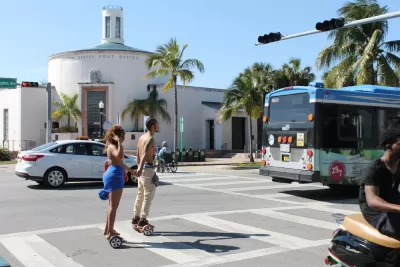The new mobility landscape requires a few key roles from government.

As cities navigate their way through the new mobility landscape and try to figure out what and how they should be regulating new business and service models, two key roles of government are emerging – one to help create a level playing field for all of these services and two to shape these services to help achieve community goals.
A large fear of the shifting models for mobility is that we will end up with a few large, private companies controlling the majority of all of our mobility options. You can imagine a future where Uber, Lyft or Waymo control e-scooter, bikeshare, and ride-sourcing services and we each subscribe to one of their vertically integrated services. One – of the many – large problems with this scenario is that it centralizes control of an absolutely ubiquitous and public need in the hands of a few private entities. Another large concern (and one that could mitigate the first) is that it stifles competition. How would any new mobility concept be able to spread it wings as so many are doing right now if the market is held by a few key players. All innovation would need to happen through these larger companies as gatekeepers and consumers would suffer. The transportation equivalent of current fears about Amazon owning all of our retail options.
To combat this, governments can help create level playing fields for new mobility services. As discussed previously on this blog, the key parts of this are supporting (or creating) platforms that allow shared route/cost/time information, offer a uniform payment platform, and allow for multi-company subscription services. (See article on efforts to do some of this in Germany).
Large question will be what governments actual role is in this — should they host/build the platforms themselves, establish a shared API (such as LADOT’s Mobility Data Specifications (MDS), for instance) along with open competition regulation and allow others to create platforms, or simply create regulations/guides for the outcomes they want and let the market figure out how best to organize around these (most difficult/dubious, in my opinion). Cities will need to balance controlling the process enough to get to desired outcomes while allowing enough flexibility to attract innovators to participate.
The second role governments need to play, once a level playing field is established, is to make sure that playing field has the right shape, incentives and penalties to assure it is supporting the outcomes cities want. Imagine a situation where the open-platform leads to a situation that promotes single occupant car trips and diminishes transit use. Or a situation where this platform leads to certain areas of the city being underserved by services. Cities need to understand what levers exist to shape new mobility services to be equitable, economically supportive of their communities, sustainable, and lead to positive health outcomes. Cities should not be in the business of capriciously or politically favoring one company over another, but they absolutely should be in the business of promoting modes and services that support community goals. In this vein of thinking, Urbanism Next put together a recent report in partnership with the cities of Portland, Seattle and Vancouver that looked at how to regulate AVs (and New Mobility to an extent) with a view towards the cities GHG emission goals.
The mobility landscape is definitely in flux and cities need to think through the outcomes they want, and how best to get there. Allowing for competition and supporting services that support community goals are key steps to doing that.
FULL STORY: CITIES NEED TO CREATE LEVEL PLAYING FIELDS (THAT TILT TOWARDS COMMUNITY GOALS)

Planetizen Federal Action Tracker
A weekly monitor of how Trump’s orders and actions are impacting planners and planning in America.

Congressman Proposes Bill to Rename DC Metro “Trump Train”
The Make Autorail Great Again Act would withhold federal funding to the system until the Washington Metropolitan Area Transit Authority (WMATA), rebrands as the Washington Metropolitan Authority for Greater Access (WMAGA).

The Simple Legislative Tool Transforming Vacant Downtowns
In California, Michigan and Georgia, an easy win is bringing dollars — and delight — back to city centers.

The Small South Asian Republic Going all in on EVs
Thanks to one simple policy change less than five years ago, 65% of new cars in this Himalayan country are now electric.

DC Backpedals on Bike Lane Protection, Swaps Barriers for Paint
Citing aesthetic concerns, the city is removing the concrete barriers and flexposts that once separated Arizona Avenue cyclists from motor vehicles.

In These Cities, Most New Housing is Under 441 Square Feet
With loosened restrictions on “micro-housing,” tiny units now make up as much as 66% of newly constructed housing.
Urban Design for Planners 1: Software Tools
This six-course series explores essential urban design concepts using open source software and equips planners with the tools they need to participate fully in the urban design process.
Planning for Universal Design
Learn the tools for implementing Universal Design in planning regulations.
Smith Gee Studio
City of Charlotte
City of Camden Redevelopment Agency
City of Astoria
Transportation Research & Education Center (TREC) at Portland State University
US High Speed Rail Association
City of Camden Redevelopment Agency
Municipality of Princeton (NJ)


























